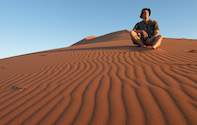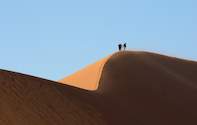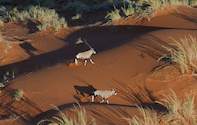
The sun rises suddenly in the desert: within an hour its rays are beating hammer blows down onto the Namib's surface. lt is hard to believe anything could survive out here. Flying over the Namib Sand Sea that surrounds Sossusvlei you can only marvel at the sheer extent of this arid vastness.
The sand comes from erosion deep in the southern African interior, from where it is carried by the Gariep, or Great, River, to the Atlantic coastline. The sand, along with an untold wealth in diamonds, has been dispersed along the coastline by the relentless, icy cold Benguela current. When it makes landfall the prevailing southwest wind is there to welcome it and usher it inland and ever northwards on its way.
It was diamonds that drew German colonists to these shores in the late 1800s, but it was the wind-driven sand that was finally their undoing along the Skeleton Coast. Today if you visit the abandoned old diamond mining settlements at Kolmanskop, Elizabeth Bay or Conception Bay you will find buildings eaten away by driven sand, rooms piled high with sand, machinery rotten with salt and sand. Those who still live in and around the sand sea at places like Luderitz and Walvis Bay say you eventually get to enjoy the taste and texture of sand in everything you eat.
When the sand, driven by the relentless wind, reaches the Kuiseb River canyon inland of Walvis Bay;it is captured there and slowly returned to the sea, where the cycle continues.
The Nature of Eternity

The sand sea, as the great sandy waste of the southern Namib Desert is known, recalls the scene from James Joyce's Portrait of the Artist as a Young Man, where a priest delivers a sermon on the meaning of eternity. In it a dove comes every hundred years and takes a grain of sand; how long, asks the priest, before it builds a mound, how long before a mountain? And yet, after the dove has moved every grain of sand on earth hardly an instant of eternity will have passed.
Namibia certainly makes you think about these things. It is a frequently repeated observation that this is a country God made in anger. As evidence of this, it is pointed out that Namib is the oldest desert on the planet and Namibia has among the lowest rainfalls of all countries on earth. There is no permanent water between the rivers that define the country's southern and northern borders. None whatsoever. What there is though, is a lot of sand, with most of the rest of the landscape covered by dark volcanic rocks.
Even when the dunes shimmer in the searing summer heat, in the anvil grip of the hottest summer days, if you look you will see life in all its unexpected glory - the arid equivalent of what Charles Darwin called "the tangled bank" of life. Most conspicuous are the ostriches, springboks, Hartmann's mountain zebras and oryx antelope with their heat-coping adaptations that preclude the need to drink water on a regular basis. As these animals amble along, grazing on desert grasses and lichens, they seem to float on the shimmering mirages of midday.
Sossusvlei Creatures Great and Small

In isolated places, if you know when and where to look (the lower hummocks of Dune One at Sossusvlei about an hour after sunrise is a good bet), you will see one of the desert's exceptional avians: the dune lark that lives only in the Namib Sand Sea. It flies as well as any lark - and you will struggle to get up the dose for a photograph - but it feeds by dashing about between tufts of tough ostrich grass, pecking at beetles and ants.
The sidewinder, or Peringuey's adder, is the only snake in the world that has its eyes on the top of its head. It wiggles its body into the sand so that just the top of its triangular head is visible, with its scales and eyes the colour and appearance of shimmering grains of quartzite. Almost perfectly camouflaged it lies in wait for an unsuspecting lizard. Meanwhile, tile lizards rush out from their sandy hiding places to grab along-legged tenebrionid beetle or an ant. As things hot up shovel-snouted lizards do a feverish dance, lifting one foot and men the other, so they do not burn like paper set alight.
The palmato gecko is an oilier creature that is custom-made for the sand sea. It has slightly webbed feet (palmate, from which it gets its name) for swimming on the dune faces, with a hardened nose shield that allows it to dive into the sand when threatened. Its nostrils are located on the top of its head to keep sand grains out (which would be useful for humans when jumping into water).
In all, there are 258 reptiles found in Namibia, 125 of which are lizards, the largest number in Africa and maybe the world. Around three-quarters of them are endemic. But these numbers pale into insignificance when compared to another class of desert creature, the insects.
If you decide to do some macro photography in the dunes you will want to be on the lookout for snakes, spiders, scorpions and the like. However, do not overlook the dune ants that swarm around the nest holes. Before you know it, the soldiers will be clambering all over you and attacking any exposed skin with small but extremely sharp secateurs, drawing immediate and copious amounts of blood. But it is the beetles of this desert that are most numerous and in many ways the most engaging of all its inhabitants.

 Little Kulala Lodge near Sossusvlei in the Namib Naukluft Park, Namibia, offers magnificent dune scenery to the west and rugged Namib mounta...
Little Kulala Lodge near Sossusvlei in the Namib Naukluft Park, Namibia, offers magnificent dune scenery to the west and rugged Namib mounta... Namib Desert Attractions - A visit to the arid plains and red sand dunes of the Namib Desert leads to many safari experiences such as climbi...
Namib Desert Attractions - A visit to the arid plains and red sand dunes of the Namib Desert leads to many safari experiences such as climbi...